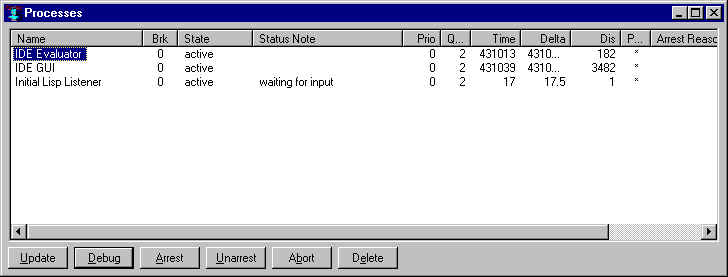Process
The process dialog displays information about the processes within
Lisp. See multiprocessing.htm for
information on processes.

Click on the Update button to update the display. It is not updated
automatically.
The Headings
-
Name: The name of the process
-
Brk: The break level of the process. A process enters a higher
break level when an error is signaled but not handled. Other
conditions, when signaled, may put a process in a break level under
certain circumstances (when
*break-on-signals* is true, e.g.) Break level 0
means no unhandled error or condition.
-
State: The state of the process (active, runnable, waiting, etc.)
-
Status Note: The "whostate" of the process (as returned by
process-whostate). While the value
can be any string, it usually describes what the process is doing.
-
Prio: The priority of the process.
-
Quantum (Q... in the illustration): The process quantum.
-
Time: the (approximate) total cpu time consumed by the process.
-
Delta: The cpu time consumed since the last report.
-
Dis: The number of times the process has been resumed since the last
report.
-
Profilable (P... in the illustration) A * in the column indicates the
process can be profiled.
-
Arrest Reasons the arrest reasons (as returned by process-arrest-reasons) of the
process.
The buttons
-
Update: update the display.
-
Debug: display the process stack backtrace in the debug window.
-
Arrest: Arrest the process for arrest reason "debugging".
-
Unarrest: Remove (if possible) the arrest reasons of the process.
-
Abort: Unwind the process thread clearing all errors and break levels.
-
Delete: Kill (and delete) the process.
See also the top-level command :processes.
Copyright (c) 1998-2002, Franz Inc. Oakland, CA., USA. All rights reserved.
Documentation for Allegro CL version 6.2. This page was not revised from the 6.1 page.
Created 2002.2.26.

